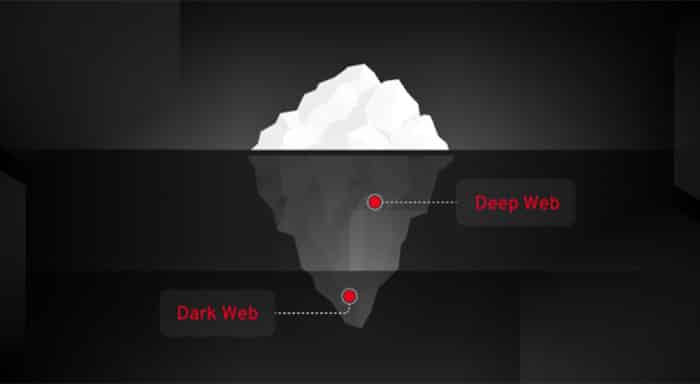The dark web. Often misinterpreted, it is one of those items that arouses interest. While news stories usually make it sound like a hidden world brimming with mystery, movies and television shows often depict it as a hazardous area teeming with criminal activities. But what does it look like? Does it resemble a dirty digital environment from the early days of the internet, or is it packed with sleek, high-tech sites?
This post will clarify the dark web for you and address that issue. Not only will you see what it looks like, but also what underlies the design, how it functions, and the instruments required for safe access. Buckle up; we're going deep into the internet's hidden areas.
Grasping the Internet's Layers
Surface Web vs. Deep Web vs. Dark Web
Understanding the dark web requires first knowing how it fits into the larger scene of the internet. Picture the internet as a layered cake:
- Surface Web: This is the section of the internet you use daily. It comprises sites searchable by Bing or Google. Among the illustrations are online shopping websites, news organizations, and social media. Anyone with an internet connection can see and access it completely.
- Deep Web: This layer covers all online material, not search engine indexed. This might be anything from academic publications, encrypted email services, private databases, or anything behind a paywall or password-protected website. Although you cannot look for it using conventional search engines, it is neither naturally harmful nor unlawful.
- Dark Web: The most private section is this one. It's deliberately concealed and calls for specific tools such as TOR to reach. Dark websites are often anonymous, and their material can be anything from innocuous to very unlawful.
Their Differences
- Surface: Open to everyone, searchable by search engines, and readily available.
- Deep Web: Not search engine indexed, yet totally legal and usually safe.
- Dark Web: Hidden and encrypted, usually needing TOR or other specialized software to reach, the dark web is commonly linked with anonymity.
The Real Appearance of the Dark Web
If you're wondering what dark web pages look like, you are in for a surprise. Usually, they are quite simple. Gone are the polished designs and beautiful photos you see on the surface web. Many dark websites resemble text-heavy, early internet days with nothing in the way of pictures and a lot of raw, unstyled HTML. Why? Since it's about anonymity, not attention-grabbing design. The less glitzy it is, the more difficult it is to track down or trace.
Visual Content vs. Text-Based
Text rules the dark web. Many websites show a lot of text—sometimes huge paragraphs of information or code-heavy displays—using simple HTML. Images and multimedia components are fewer since they take longer to load and could expose identifying information, including device fingerprinting or location. Often, when you come across photographs, they are hazy and low-resolution.
Common Dark Web Site Examples
Some usual websites you could come across on the dark web are:
- Marketplaces: Some of these operate like eBay; rather than selling genuine items, they may sell stolen credit card details, fake merchandise, or illegal drugs.
- Forums: Dark web forums exist for conversations on hacking, privacy, or conspiracy theories. While some may be safe havens for individuals debating contentious issues, others could emphasize unlawful behavior.
Dark Web Access Tools
The Onion Router, or TOR
The most used way to reach the dark web is TOR. Free and open-source, it bounces your internet data around the world through several servers known as "nodes." Nearly tough to track, its multi-layered encryption helps conceal your identity and position. Websites on the black web terminate with the .onion domain and can only be accessed with TOR.
Additional Networks and Browsers
Although I2P and Freenet are alternative options, TOR is the most often utilized way to reach the dark web. Though less well-known or not as user-friendly as TOR, these operate on comparable ideas.
Safety Measures When Accessing
Should you choose to investigate the dark web, keep in mind that it may be risky. Always use a VPN to further conceal your identity, maintain your software current, and never download files from dubious or unknown sources. Always be careful about what you click, and stay away from interacting with any harmful material.
Usually, on the Dark Web, You Will Find Legal and Illegal Content
Though not all of it is malicious, the dark web is usually linked with illegal activity. Among the acceptable uses of the dark web include protecting journalist communication in repressive nations, evading censorship, and offering privacy for individuals in politically unsafe areas.
The darker side, though, is made up of underground markets offering drugs, stolen information, and unlawful services, hence care is essential.
Forums and Marketplaces
Some dark web marketplaces mimic online storefronts; instead of selling normal items, they usually feature illicit ones including phony IDs, illegal substances, firearms, or hacking tools.
These could be focused on conspiracy theories, privacy, politics, or hacking. While some are just informational, others could support criminal behavior.
Activism Platforms and Whistleblowing
Apart from illicit material, there are sites enabling individuals to safely reveal business or government misconduct. WikiLeaks is one such site offering whistleblowers a secure platform free from retribution to publish private papers.
Is the Dark Web All Dark?
Mythology vs. Reality
Contrary to common opinion, the dark web is not completely populated with criminals and hazardous activities. Many utilize it for privacy, including journalists working under perilous governments and those safeguarding their internet identities.
Legitimate Dark Web Uses
The dark web has many good, non-criminal uses:
- In repressive countries, activists can talk safely.
- Reporters can make sure their sources stay unknown.
- In a society where privacy is diminishing, individuals can safeguard their identities.
Dark Web Design Aesthetics: Why Sites Appear Basic or Outdated
On the dark web, anonymity and security take center stage; design is not as important. The aim is to maintain the website as lightweight as possible with fewer visuals and layout components to avoid disclosing any information about the user or the server running the site. Sites were purposefully developed to promote secrecy, hence many seem as though they were designed decades ago.
Deliberate Lack of Branding
Most dark web sites lack branding since personal identifiers like logos and particular themes could expose too much about the site owners. Anonymity comes first; so, branding sometimes becomes secondary.
Minimal Images and Monospace Fonts
Often, monospaced typefaces like Courier New are employed since they simplify layout and stop font fingerprinting. Images are uncommon because of privacy issues and lengthy loading times. Most dark websites value the security that comes with little visibility and the efficiency of text.
Usability and Navigation .onion URLs
Dark websites' URLs finish in .onion, a unique domain for concealed websites. Part of the design's emphasis on anonymity is these randomly produced, long, hard-to-remember or guess URLs.
Search Engines and Bookmarking
Specialized search engines for the dark web, such as Ahmia, index .onion pages. Many dark web users, though, don't utilize search engines because of the privacy emphasis and would rather browse using curated lists such as Hidden Wiki.
Indexes and Hidden Wiki
Listing several .onion domains, the Hidden Wiki is among the oldest index pages on the dark web. But it's really important to be cautious here since many connections point to hazardous or dubious material.
Risks of Dark Web Browsing
Scams and Malware
Sadly, the dark web is teeming with scammy websites that try to put spyware on people's computers or entice them into fraud. Always be careful while surfing and stay away from downloads.
Law Enforcement Stings
Some websites are run by police to catch offenders. Known as "honeypots," these websites gather data on those who engage with them.
Moral and Ethical Dilemmas
Just seeing some material could place you in a moral dilemma even if you don't participate in criminal conduct. Even the most experienced internet users may find some of the alarming material quite disconcerting.
Actual User Experiences
User Opinions on Dark Web's Appearance and Feel
Many users find the dark web to be a digital time capsule; it's like being in a 90s-era forum with only text and basic links. Described by others as unnerving yet fascinating, it is almost like investigating uncharted territory.
Reddit and Forum Personal Stories
Users on sites like Reddit frequently post their encounters with the dark web. While others point out the feeling of privacy and anonymity it offers, many say they are astonished by its simple design and the often unsettling environment.
Anonymity's Function
- No Signatures or User Profiles: The dark web lacks comprehensive personal signatures or social accounts. To maintain their anonymity, users frequently use arbitrary usernames or aliases.
- Using Encryption and Pseudonyms: Maintaining privacy depends on encrypted communications and pseudonyms. The dark web won't provide many actual names or identifying information.
Imagining the Dark Web
Is it possible to really "see" it?
Though TOR gives you access to the dark web, you cannot "see" the whole internet. It's not a graphical interface like the surface web, so you can't easily search through it as you would Google.
Graphical Maps and Screenshots
Because of its encrypted character, the dark web has no official graphical representations or maps; however, several third-party applications try to offer visual indexes of live .onion sites.
Development Through Time
Has the Dark Web Changed in Appearance?
Over the years, the dark web's design—functional, straightforward, and anonymous—has stayed rather constant. Though the design is still basic, some contemporary dark websites have begun to use a somewhat more user-friendly layout.
Surface Web Design's Impact on the Dark Web
Some more recent dark web sites mimic surface websites in their layout. Nevertheless, a fundamental tenet of the dark web look is the absence of glitzy graphics or tracking systems.
Why It Appears the Way It Does
- Simplicity for Speed: Dark websites employ simple designs that load fast and lack external scripts that can expose information, hence lowering the danger of being tracked or identified.
- Avoiding Fingerprinting and Tracking: Keeping things basic guarantees anonymity by helping to stop anyone from gathering personal data from users.
- First, Security: Above all, the dark web's design gives security top priority; simple websites help to lower danger and safeguard user identification.
Key Takeaways About the Dark Web
What, therefore, is the dark web really like? It's not a glitzy, high-tech universe of luxury graphics and neon lights. Rather, it is a simple, text-heavy area meant for anonymity and security. Although the dark web hosts a mix of legal and illicit activities, it also provides reasonable purposes for privacy-minded people. Should you choose to investigate it, always be careful and ensure your safety.
FAQs
Q1: Does dark web browsing constitute illegality?
No, visiting the dark web itself is not against the law. Activities you participate in on the dark web could be unlawful.
Q2: Does browsing the dark web make you vulnerable to hacking?
Certainly, one runs the danger of coming across fraud or malware, hence it's crucial to be careful by avoiding dubious links and using a VPN.
Q3: What causes dark web sites to seem antiquated?
Their priorities are speed, simplicity, and anonymity; thus, fancy designs or slow-loading pages are unnecessary.
Q4: How can one safely investigate the dark web?
Use TOR and a VPN at all times; don't download files; just go to reliable websites.



